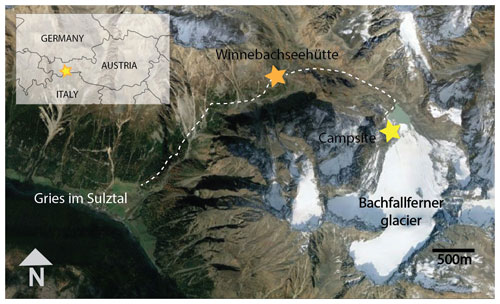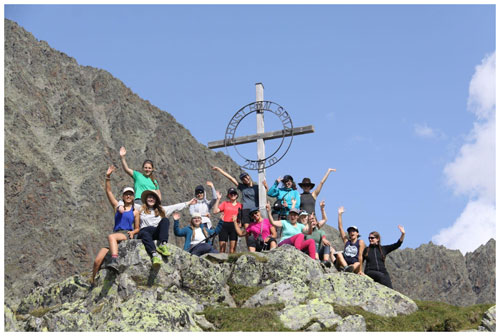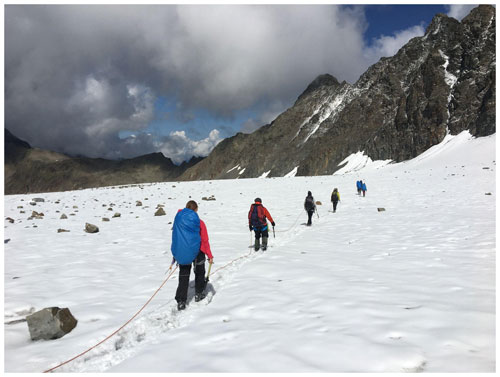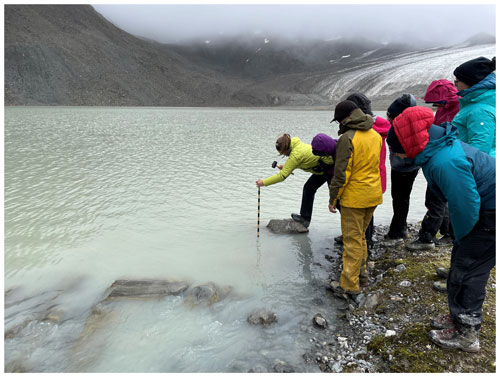the Creative Commons Attribution 4.0 License.
the Creative Commons Attribution 4.0 License.
Glaciers are for girls: the inaugural expedition of Girls on Ice Austria succeeded in empowering nine young women in August 2021
Girls on Ice Austria, an organization that encourages young women to stretch themselves through wilderness and glacier travel, camping, science and art, successfully completed their inaugural expedition in August 2021. Nine girls from Austria, Germany and Italy joined science instructors specializing in glaciology and meteorology, two professional artists (an actress and a painter), and a professional mountain guide for an all-female, week-long expedition to Bachfallferner glacier in the Ötztal. The team learned basic mountaineering and climbing skills, conducted scientific experiments including measuring the daily melt rate of Bachfallferner glacier, and pushed their creative boundaries. The all-female nature of Girls on Ice, and Inspiring Girls Expeditions (the umbrella organization) is meant to show young girls that women are capable of successfully filling traditionally male roles (such as in glaciology and mountaineering), to introduce the next generation of girls to the world of mountains and glaciers, and to encourage them to bravely and confidently pursue these career paths.
- Article
(5191 KB) - Full-text XML
- BibTeX
- EndNote
An overcast August sky opens up to icy rain. She pulls her hat down low with cold hands, taking in the landscape: wispy stratus clouds dance along the lake, and the glacier stands shrouded in mist. Shades of white, grey, and green, brushed with a late summer snow. She remembers how their art instructor asked them to sit and take in the alpine hues on their first evening, to appreciate the shapes, colors, and lines; the saturation of a late afternoon sky; and the elegance of a ridgeline cloaked in fog. The glacier in the distance is Bachfallferner glacier – one of many rapidly retreating Alpine glaciers (Fig. 1). Ice in polar and high mountain regions has been melting rapidly in recent years, and this week she will learn how to help track this by measuring the daily melt rate of the glacier, the subsequent rise of the lake level below, and the fluctuating discharge of the stream that exports the meltwater. She is half way through one of the most challenging weeks of her life: a week of sleeping in a tent on a moraine; of challenging her fear of heights by learning how to rock climb; and confronting her claustrophobia by abseiling into a glacial crevasse. The feeling of empowerment will come later. Right now, she is a bit cold.

Figure 1Location map showing the campsite, Bachfallferner glacier, Winnebachseehütte, and the hiking route from Gries im Sulztal. The small inset map on the upper left shows the location of Bachfallferner glacier in relation to Austria, Germany and Italy. The satellite image is from ©Google Earth Pro (image from October 2017).
She is part of an all-female team on a 7-day expedition high above the Ötztal in Tyrol and at the foot of Bachfallferner glacier, on the first-ever expedition run by Girls on Ice Austria (Fig. 2). Girls on Ice Austria is part of the umbrella organization Inspiring Girls Expeditions (IGE), which originated in the Cascade Mountains of the United States, and has since branched out to Canada, Europe, and Asia. The purpose of IGE is to take young women (∼ 15–17 years old) into a challenging and inspiring mountain environment and provide them an opportunity to realize their potential as scientists, artists, and mountaineers, and as strong and capable young women. The program is free for participants – they are not selected by their ability to afford the trip. Instead, girls who are at a turning point or time of transition in their lives and could benefit from the experience are given priority. IGE has branched out thematically in past years, and now includes expeditions such as Girls on Icy Fjords, Girls on Rock, and Girls in the Forest. Outdoor and science-based programs similar to Inspiring Girls Expeditions exist in the United States and Europe, such as the US-based Juneau Icefield Research Program (https://juneauicefield.org/, last access: 23 January 2022), the National Outdoor Leadership School (https://www.nols.edu/en/, last access: 23 January 2022) and Outward Bound, which has branches in Germany (https://www.outwardbound.de/de, last access: 23 January 2022) and Austria (https://www.outwardbound.at/de, last access: 23 January 2022). The Austria-based Naturerfüllt Mädchenkraft (https://www.naturerfuellt.at/mädchenkraft/, last access: 23 January 2022) outdoor program for girls is also similar to IGE. One key difference between these programs and IGE, however, is that IGE does not charge the students to participate.
Girls on Ice Austria is the newest branch of Inspiring Girls Expeditions. Lindsey Nicholson, an assistant professor at the University of Innsbruck in the Department of Atmospheric and Cryospheric Sciences, is the life force behind the new chapter. After hearing about Inspiring Girls Expeditions for years, she decided to start a branch based in Innsbruck, and within a year, raised funds, recruited volunteers, and led the organization of a successful first expedition in August of 2021. Starting Girls on Ice Austria was a decision rooted in passion for inspiring girls to be leaders and to care for glacial environments.
“For me, finding my love of being and learning about the natural environment outside was not straightforward, as it was not an interest shared by my family”, Nicholson said. “I strongly believe in the principle that `if she can see it she can be it', and on that basis I hope that the Girls on Ice experience can broaden the horizons of our participants, and help them find their own path in life”. The Austrian branch invites applications from Austria, Germany, and South Tyrol, and this year their team consisted of six Austrians (including one participant who had recently immigrated from Afghanistan), two Germans, and one Italian. Saleha, one of the student participants, wrote the following reflection about her experience:
I'm Saleha and I'm from Afghanistan. I have been living in Austria for eight months. This was the first time that I traveled alone with other people. And it was really great. At first, I thought it was going to be very hard because my backpack was so heavy and I have never hiked with a heavy backpack before. And even though my German wasn't good, I went anyway. I made new friends and I'm very happy about that. Because my German isn't that good, I thought it would be very difficult, but no, we had really nice teachers who always paid attention to me. And I really enjoyed it. And we walked on the glacier and abseiled down crevasses and at night we slept in tents and that was a lot of fun. We often made tea when it was cold. It was very nice to warm up. It was a great experience for me and I hope to participate in such a program again. In the end, I would like to thank everyone who made this expedition possible.
In IGE, every member of the team, from start to finish is female. Imagine – quickly, without overthinking it – a scientist, an explorer, a mountaineer, a famous artist, and a gear porter. Are you picturing a man? Chances are quite good that you are. In recent years, efforts have been made to increase female representation in those fields, and it is certainly improving. However, there is still work to do, especially in the realm of empowering the young girls who will become our future leaders. On all IGE expeditions, the planning and organizing is done by women, the instructors are all women scientists and artists, the gear porters are women, and a female mountain guide joins to teach mountaineering and safety skills. Many women are taught alpinism or science from men – it is important to show young girls that women can also be the instructors and the final decision makers in the field.
Only about 2 % of mountain guides in the Österreichischen Bergführerverband (Austrian Mountain Guide Association, https://www.bergfuehrer.at/, last access: 30 September 2021) are women, but more than ever they are currently in training, indicating that the number of women who dare to become climbing guides is increasing. Even so, the Girls on Ice Austria team had some difficulty finding an available female professional mountain guide and was lucky to find Magdalena Habernig as a capable and supportive guide. “Girls on Ice was a completely new experience for me that I would not want to miss again”, Magdalena said of the experience. “I was always amazed at the energy with which the girls mastered and accepted the often tough conditions at the camp. I was also pleased that every single one of them had the courage to abseil into the crevasse and rock climb. The mood in the camp was always good, not only when the sun was shining, but also when it was raining, muddy, windy and cold. Sitting together and `answering the question of the day,' we had many interesting conversations, not only on a scientific level”.
During the expedition, nine participants, three scientific instructors (Lindsey Nicholson, Annelies Voordendag, and Anna Maria Trofaier), two artists (Marie Schmidt, an actress, and Jessie Pitt, a landscape painter), and a mountain guide (Magdalena Habernig) camped, learned, discussed, and pushed their limits at the toe of Bachfallferner glacier, high above the Ötztal (Fig. 1). Although the instructors drafted a schedule in advance, a turn in weather conditions forced them to rearrange the order of events.
On the first day, the team stayed at a campsite in Huben; the afternoon involved packing backpacks, a pizza dinner, and a small birthday party for one of the participants, Anne, who turned 16 that day. Early the next morning, the girls shouldered their heavy packs and marched up the mountain – over 1000 m of elevation gain. It was a difficult day with a heavy load, but the weather was perfect. For Hemma, the hike to base camp with a heavy pack under the hot sun was the hardest part, but the arrival at base camp was her favorite memory: “the moment we arrived at base camp exhausted. … I already knew it was going to be a week full of awesome memories”.
The blue skies and sunshine did not last long – on Day 3 the rain began and fell so hard that the team was forced to descend to Winnebachseehütte for a night (Fig. 1). Marie Schmidt, the team's acting instructor, took advantage of these calm moments to introduce the girls to improvisational theater, an activity often outside of one's comfort zone that expands creativity and confidence. Dry spells on Day 4 allowed them to learn how to rock climb at Kleinkanada, a small climbing area near the Hütte. Rain persisted again on Day 5, but Day 6 was sunny and beautiful, and the girls spent the entire day on Bachfallferner glacier, mastering the art of walking in crampons, learning about glaciology, and abseiling into a crevasse (Fig. 3).
The following day was their last full day on the glacier, and the girls wrapped up their science experiments, some of which had been ongoing throughout the week. One group measured the glacier's daily melt, and another investigated the effect of snow cover on ice and snow temperatures. The girls used pegs lodged in the snow and ice to measure both ice and snow levels throughout the week. Together, they found that although the snow melted faster than the ice, the snow potentially acted as a cover for the ice, decreasing its melt rate. A third group tracked the changing velocity and water level in a stream draining Bachfallferner, using a peg lodged in the stream bed to measure the water depth and the channel's cross-sectional area. They also measured the lake level throughout the day (Fig. 4). A fourth group marked the growth of wildflowers colonizing surrounding moraines.
That week, the girls observed the short-term melting of Bachfallferner glacier but also learned of its progressive demise on longer timescales. Since the year 2000, glaciers in the Alps have lost 17 % of their volume, which is 22 km3 of ice (Sommer et al., 2020). In polar regions, ice caps are melting rapidly as well (i.e., Slater et al., 2021). In fact, according to the National Oceanic and Atmospheric Administration's 2021 Arctic Report Card, Arctic regions are melting twice as rapidly as the rest of the world's ice-covered regions (Moon et al., 2021). Globally, glaciers are estimated to have lost ∼ 267 Gt yr−1 from 2000 to 2019, which amounts to 21 % of observed sea-level rise (Nerem et al., 2018; Hugonnet et al., 2021). By 2100, regions with smaller glaciers, such as Central Europe, are expected to lose over 80 % of their current ice mass (IPCC, 2019).
Changes occurring in glaciated areas are more apparent and striking if one observes a glacier, measures its daily melt, travels on its surface, and dives into its crevasses. Not only did the Girls on Ice participants complete their expedition with new confidence in their abilities, but also with a deeper understanding of the gravity of climate change and glacial melt in alpine regions. Even if these girls decide not to become glaciologists, they will remember this experience and will perhaps pass on their understanding, by telling friends and family, or even supporting initiatives to measure environmental changes in alpine or polar regions, or making environmentally conscious decisions in their personal lives.
Annelies Voordendag, a PhD student in the Department of Atmospheric and Cryospheric Sciences at the University of Innsbruck, remarked on the progress the girls made between Day 1 and the end of their journey:
The self-confidence of the girls really increased. The first day we took pictures and the girls slightly smiled, but they did not show that much self-confidence. When we returned, with dirty clothes and greasy hair, their smiles were bigger and they stood more upright. That's what such a program can already acquire in a week!
In a couple of generations, glaciers may only exist as relict geomorphological features that we must describe to our children and demonstrate with outdated photographs. But what is not disappearing are women. Half of the world's population will always be female, and with a world that is changing and suffering climate change and environmental harm, the world needs women in power to make decisions and prioritize cooperation. For that to happen, the next generation of women must be encouraged to believe in themselves, to fully trust in their abilities and that they make good decisions, to challenge themselves and to know that they can make it through one of the hardest, coldest, and heaviest weeks of their lives, and then realize that they can do even more next time, as a team. For Lena, her favorite part of the expedition was “moments when we felt that we were a team”.
The Girls on Ice Austria website can be found here: https://www.inspiringgirls.org/goi-austria (last access: 23 January 2022), and the Inspiring Girls Expeditions website can be found here: https://www.inspiringgirls.org/ (last access: 23 January 2022). Through the website, you can apply to join an expedition as a participant, get involved as a volunteer, or donate to a particular expedition. Inspiring Girls Expeditions Europe, which includes Girls on Ice Austria and Girls on Ice Switzerland, is on Twitter and Instagram as @ige_eu and on Facebook as Inspiring Girls Expeditions Europe.
No data sets were used in this article.
The author has declared that there are no competing interests.
Publisher's note: Copernicus Publications remains neutral with regard to jurisdictional claims in published maps and institutional affiliations.
The Girls on Ice Austria organizational team would like to warmly thank all of the volunteers who gifted their time, energy, and donations to the expedition. Girls on Ice Austria is entirely volunteer-run and cannot function without a community effort and donations to fund the expedition each year. We are also grateful for the effort, enthusiasm, and bravery of the participants on the expedition. The author would like to thank the organizational core team members for reviewing this article and providing quotes, APECS members for encouraging the submission of this piece, and Rainer Lehmann for his careful review.
This paper was edited by Donovan Dennis and reviewed by Rainer Lehmann.
Google Earth Pro 7.3.4.8248 (64-bit): Oct. 17 2017, Bachfallferner glacier, Austria. 47.076554∘, 11.060942∘, eye alt. 3 km, https://earth.google.com/web/ (last access: 28 September 2021), 2017.
Hugonnet, R., McNabb, R., Berthier, E., Menounos, B., Nuth, C., Girod, L., Farinotti, D., Huss, M., Dussaillant, I., Brun F., and Kääb, A.: Accelerated global glacier mass loss in the early twenty-first century, Nature, 592, 726–731, https://doi.org/10.1038/s41586-021-03436-z, 2021.
IPCC: Summary for Policymakers, in: IPCC Special Report on the Ocean and Cryosphere in a Changing Climate, edited by: Pörtner, H.-O., Roberts, D. C., Masson-Delmotte, V., Zhai, P., Tignor, M., Poloczanska, E., Mintenbeck, K., Alegría, A., Nicolai, M., Okem, A., Petzold, J., Rama, B., and Weyer, N. M., https://www.ipcc.ch/srocc/chapter/summary-for-policymakers/ (last access: 23 January 2022), 2019.
Moon, T. A., Druckenmiller, M. L., and Thoman, R. L. (Eds.): Arctic Report Card 2021, https://doi.org/10.25923/5s0f-5163, 2021.
Naturerfuellt Mädchenkraft website: https://www.naturerfuellt.at/mädchenkraft/, last access: 23 January 2022.
Nerem, R., Beckley, B., Fasullo, J., Hamlington, B., Masters, D., and Mitchum, G.: Climate-change-driven accelerated sea-level rise detected in the altimeter era, P. Natl Acad. Sci. USA, 115, 2022–2025, 2018.
Slater, T., Lawrence, I. R., Otosaka, I. N., Shepherd, A., Gourmelen, N., Jakob, L., Tepes, P., Gilbert, L., and Nienow, P.: Review article: Earth's ice imbalance, The Cryosphere, 15, 233–246, https://doi.org/10.5194/tc-15-233-2021, 2021.
Sommer, C., Malz, P., Seehaus, T., Lippl, S., Zemp, M., and Braun, M.: Rapid glacier retreat and downwasting throughout the European Alps in the early 21st century, Nat. Commun., 11, 3209, https://doi.org/10.1038/s41467-020-16818-0, 2020.







